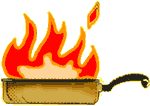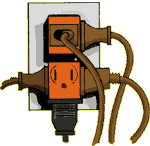Facts about Fire...
Most people will never face a
major fire. But don't think that it will never happen to you.
Statistics show that your life will be affected by fire three
times, either through personal experience or the experiences of
family and friends. Knowing what to expect and how to react can
be the difference between life and death.
FACT:
In a fire, you can't see anything because
of the thick black smoke. Expect total darkness.
SOLUTION:
Thick black smoke will fill a room from the top down. Crawl
along the floor to escape and keep a flashlight nearby to help
you see.
FACT:
The smoke and gases produced by a fire can
kill you. If you breathe these gases while you're sleeping, you
may never wake up. If you breathe them while you are awake, you
may become dizzy, disoriented and die.
SOLUTION:
Have a smoke alarm in all sleeping areas to warn and wake you.
Make sure they are working. Test them monthly and change the
batteries annually.
FACT:
Fire is extremely hot. The heat alone can
kill you.
SOLUTION:
The coolest air will be along the floor. Crawl along the floor
while you escape from a fire and keep your head in the safe zone
between 30 to 60 cm (12 to 24 inches) from the floor. Make sure
you and your family practice crawling when rehearsing your
escape plan.
FACT:
Clothes can catch on fire.
SOLUTION:
STOP where you are, gently DROP to the floor, cover your face
with your hands and ROLL quickly from side to side until the
flames go out. To help someone else who is on fire, push them to
the ground and have them roll. Cover them with a wool or cotton
blanket to smother the flames.
FACT:
Fire is extremely hot. The heat alone can
kill you.
SOLUTION:
The coolest air will be along the floor. Crawl along the floor
while you escape from a fire and keep your head in the safe zone
between 30 to 60 cm (12 to 24 inches) from the floor. Make sure
you and your family practice crawling when rehearsing your
escape plan.
FACT:
Burns need proper treatment.
SOLUTION:
1. Put the burned area under cool water for at least ten
minutes.
2. NEVER put ice, lotions or butter on a burn.
3. If the burn blisters or chars, see a doctor
immediately. Don't try to bandage it yourself.

National
statistics show that on the average, every person in this
country will experience two kitchen fires in their lifetime.
Hopefully, you will avoid a fire in your kitchen.Those of you
who are prepared and know how to respond to this kind of an
emergency can minimize damage.

When a
kitchen fire strikes, know what to do! The most common kitchen
fire starts in a pan or on top of the stove. When it happens,
don't try to move it. In doing so, you will only increase the
chances of spreading the flames.
How to
extinguish
1. Try to extinguish the fire in the pan by
slowly sliding the lid over the pan. Don't try to throw the lid
on from a distance or place the lid directly on the pan.
2. By sliding the lid on top of the pan, you
cut off the oxygen to the fire and the fire will die.
3. Once this has been done, turn the burner off
to remove the heat source.
Caution: under no circumstances should you
attempt to put out a fire in a pan on the stove by using water.
Doing so will only increase the intensity of the fire, causing
possible injury to yourself or spreading flame to other portions
of the room.
Fire in an
oven
If a fire starts in the oven, closing the oven door will cut off
the oxygen in most cases and smother the fire. Turn off the oven
to remove the heat source and keep the oven door closed.
Fire
extinguishers
(A vital element to be utilized in the kitchen.) If you don't
have a lid that fits the pan or if the fire is too intense to
get close, you can use a fire extinguisher. Most kitchen fires
can be put out quickly if an adequate home fire extinguisher is
available and used correctly.
Have the
proper fire extinguisher and store it correctly.
It is
important to store the fire extinguisher away from the stove so
it can be easily available if a fire occurs. Don't hang it over
the stove or other potential fire areas. Your home fire
extinguisher should be approved for a B-type and C-type fire and
weigh no less than five pounds. (B-type fires involve flammable
liquids such as grease and C-type fires involve electrical
appliances).
Know how
to use your fire extinguisher
P - Pull the release pin.
A - Aim the extinguisher at the base of the fire.
S - Squeeze the lever.
S - Sweep from side to side.
Get out
Make sure that everyone is out of the house. Gather everyone out
front until the fire department arrives. Remember, once out,
stay out!
Phone 994
You should alert the fire department immediately by calling
9-9-4 (or the emergency response phone number in your area, if
different).
Common
sense rules to remember
Proper clothing: kitchen fires can ignite your clothing when
you're working around the stove. Long, frilly, or loose fitting
sleeves are likely to come in contact with the hot surface and
catch fire. You should always wear short sleeves when working
around a hot stove.
Never leave
the area unattended while cooking. If you must leave the kitchen
for any reason while cooking (i.e. phone, doorbell ringing) shut
all elements off, or take an oven mitt with you as a reminder.
Maintenance:
regular cleaning of the stove, hood, and vent system is also
important.

-
Are
fuel-burning space heaters and appliances properly installed
and used?
-
Are all
space heaters placed away from traffic? Are children and
elderly persons cautioned to keep their clothing away?
-
Has the
family been cautioned not to use flammable liquids, like
gasoline, to start or freshen a fire (or for cleaning
purposes)?
-
Is the
fireplace equipped with a metal fire screen or heat-tempered
glass doors?
-
Since
portable gas and oil heaters in fireplaces use up oxygen as
they burn, do you provide
proper ventilation when they are in use?
-
Are proper
clearances provided between space heaters and curtains,
bedding, furniture, etc?
-
Do you stop
members of your household from smoking in bed?
-
Do you
check up after others to see that no cigarette butts are
lodged in upholstered furniture where they can smolder unseen
at night?

-
Are matches
and lighters kept away from small children?
-
Do you
dispose of smoking materials carefully (not in waste baskets)
and keep large, safe ashtrays wherever people smoke?
-
Children
get burned climbing on the stove to reach an item overhead. Do
you store cookies, cereal, or other "bait" away from the
stove?
-
Do you keep
your basement closets, garage, and yard, clear of combustibles
like papers, cartons, old furniture, or old rags?
-
Are
gasoline and other flammable liquids stored in safety cans
(never glass jugs, discarded bleach bottles, or other
makeshift containers) and away from heat, sparks, and
children?
-
Is paint
kept in tightly-closed metal containers?

-
Are there
enough electrical outlets in every room and special circuits
for heavy-duty appliances such as space heaters and air
conditioners?
-
Are
furnace, stove, and smoke pipes far enough from combustible
walls and ceilings, and in good repair?
-
Is your
heating equipment checked yearly by a serviceman?
-
Is the
chimney cleaned and checked regularly?
-
For safety
against chimney and other sparks, is the roof covering fire
retardant?
-
Did you
have a qualified electrician install or extend your wiring?
-
Do all your
appliances carry the seal of a testing laboratory?

 |